The Perfected One: The Buddha
Introduction
For 2,500 years people throughout Asia and the world have taken the Buddha’s teachings and made them their own. Artists have created images of the Buddha that inspire and comfort, drawing on local traditions and materials that celebrate and venerate the life and the teachings of the Buddha. Through treasures from the Pacific Asia Museum’s collection of Buddhist art, we’ll learn why the Buddha has changed the lives of millions of people.
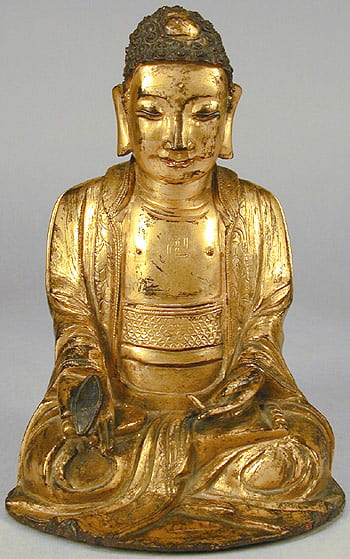
More about this artwork: Korea received Buddhism from China in the 4th century A.D. With the faith came Chinese Buddhist images, and throughout much of Korea’s history, Korean Buddhist images have been influenced by Chinese models.
As can be seen in this gilt bronze figure, Korean figures of the Buddha tend to be simple in form and decoration, and the Buddha’s robes fall with rhythmic folds. In many Korean Buddha figures, including this example, the head is slightly oversized in relation to the body, and the face is broad and slightly squared. Their faces generally appear gentle and calm, and they often display a slight smile, often called the “enigmatic” smile of the Buddha.
One notable feature of this image is the reverse of the swastika, called a sauvastika, on his chest. In Buddhism, the swastika is the symbol of the Buddha’s universality and is believed to contain within it the whole mind of the Buddha.
Seated Buddha
Korea, 16th century
Bronze with gilding
Pacific Asia Museum Collection
Gift of Mr. William Atwood in memory of Elain Spaulding Atwood, 1991.87.1
1: The Birth of the Buddha
Even before his birth, his mother and father knew Prince Siddhartha would be remarkable. After all, his father was the king of the Sakya clan in what is now Nepal. His mother, Queen Maya, had strange dreams of a white elephant while she was pregnant, and her son was born out of her right side as she stood grasping a teak tree branch in her right hand.
If this were not extraordinary enough, wise men examining the infant proclaimed that he would either stay at home and become a powerful king or leave his family and become a great spiritual leader. It was even possible that he would become a Buddha, an awakened one.
Like many fathers, King Shuddhodana, preferred that his son become powerful rather than holy, and kept him at home, shielding him from the world’s sorrows and providing him with every luxury.
Did King Shuddhodana succeed?
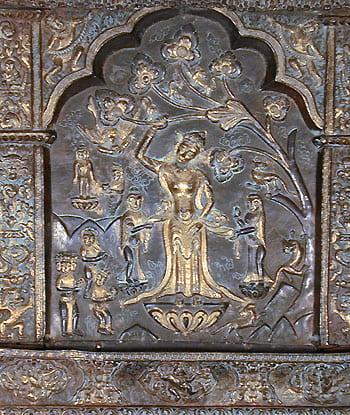
More about this artwork: Although Siddhartha Gautama, the Historical Buddha, was born in what is now Nepal in 563 B.C., he spent most of his life in India teaching and seeking enlightenment. The practice of Buddhism may have been brought to Nepal by the Indian King Ashoka in the third century B.C., and was observed most widely there between the eighth and thirteenth centuries A.D.
Buddhist art in Nepal often shows images of the Buddha in addition to bodhisattvas and other Buddhist deities. The Newari metalworkers of the Kathmandu Valley produced fine metalwork like this piece, often with gilt embellishment and inlaid with gems. Like Tibetan thangkas, this object served as an aid to study and devotion.
Like the Tibetans, the Nepalese practice Vajrayana Buddhism, which emphasizes the assistance that rituals and sacred beings such as bodhisattvas and other deities can give to help believers attain enlightenment.
Today, a small percentage of the Nepalese are practicing Buddhists, although tourism to sacred Buddhist sites is an important part of the economy. Nepal’s many stupas, monuments that house sacred Buddhist relics, are unique for the huge eyes painted on them. These eyes stand for the heavenly kings who guard the four directions of the world or the eyes of the all-seeing Cosmic Buddha.
The Birth of the Buddha
Nepal, 17th century
Copper repoussé with gilding
Anonymous promised gift, Pacific Asia Museum
2. The Buddha Attains Enlightenment
Although his father King Shuddhodana tried to shelter him, Prince Siddhartha inevitably came face to face with the world’s pain. On a rare trip outside of his home when he was 29, the prince saw a decrepit old man and was shocked at the suffering old age brings. He didn’t know that pain like this existed in the world Seeing a sick man and a corpse grieved him, and he tried to understand what he had seen. Finally, Siddhartha encountered a monk, whose peaceful expression impressed him after the misery he had witnessed.
To try and understand what he had seen, the prince gave up his luxurious home and became a monk. He took the name Gautama and wandered through northeastern India. After years of starvation and living in the open, he realized that he could not attain enlightenment through extremes. He arrived at a place now called Bodh Gaya and sat under a tree and meditated for 49 days. The evil Mara, King of Illusion, sent demons and seductive women to test Gautama’s resolve and prevent him from achieving enlightenment. He was not distracted and reached down his hand to call on the Earth goddess to bear witness to his strength, a mudra known as the Earth Touching Gesture. He then attained the enlightenment he sought, namely, he came to understand the truth of existence. He had been released from the cycle of birth and rebirth.
After enlightenment, then what?
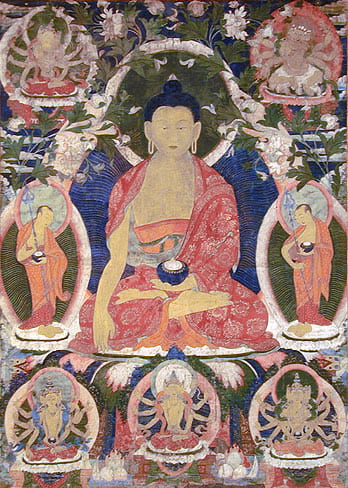
More about this artwork: This Tibetan painting depicts the Buddha just as he is attaining spiritual enlightenment, or nirvana. He is flanked by his eldest disciples, Kashyapa and the youngest, Ananda. He sits in meditation under the Bodhi tree and reaches his right hand down over his knee to touch the ground, asking the Earth to witness his unshakable resolve. This gesture is known as the Earth Touching Gesture.
Buddhist painting has flourished in Tibet, and these paintings on cloth known as thangkas, depict stories that explain Buddhist thoughts and ideas and are therefore quite elaborate.
Many incarnations of the Buddha are depicted, as are deities and spiritual leaders and scholars. Thangkas may also show scenes from the Buddha’s life and past lives, the wheel of life showing worlds of rebirth, and symbolic views of the universe.
Buddhism did not reach Tibet until the 7th century A.D. and did not become firmly established until the 10th century. Like the Nepalese, the Tibetans practice Vajrayana Buddhism, a complex form that relies on rituals and assistance from sacred beings. Tibet was one of the most devoutly Buddhist countries until China’s occupation in 1950. Its religious leader–who was sometimes also historically its political leader–is the Dalai Lama, who is considered to be the manifestation of the bodhisattva Avalokiteshvara. The current Dalai Lama lives in exile in Dharamasala, India after the invasion of Tibet by the Chinese.
Painting of the Buddha and Other Deities
Tibet, 19th century
Ink and opaque watercolor pigments and gold on cotton
Anonymous Loan
3. The Buddha Meditating
Once Siddhartha Gautama become the Buddha, the Awakened One, then what?
He could return to Nepal and become and rich and wise prince, converting his kingdom to his new beliefs. He could become a great general and force men and women throughout the land to become his followers. Instead, he continued to live a simple life of moderation as a traveling monk and did not seek fame or wealth. He believed that possessions were a burden and led men and women down the wrong path.
The Buddha’s compassion and wisdom inspired many of his followers to give up their homes and belongings to practice the truths that he had realized, called the dharma. As he reached enlightenment, he became aware of the Four Noble Truths:
1. Human existence is full of conflict and suffering.
2. Suffering is caused by selfish desires.
3. Humans can achieve liberation from suffering, which is called nirvana.
4. The Noble Eightfold Path is the way to this liberation.
What is the Noble Eightfold Path?
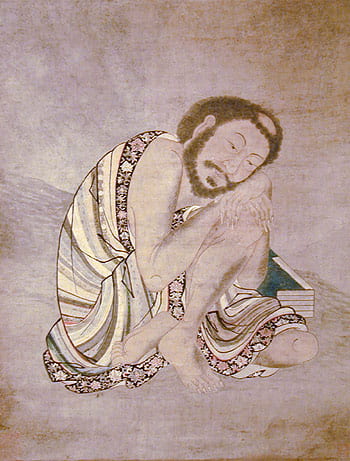
More about this artwork: Although Buddhism reached China during the first century A.D., it spread slowly along the Silk Route through that vast land. Buddhism began to flourish during the fourth century and gained support of its rulers during the seventh through ninth centuries. Many schools of Buddhism arose, forms of Mahayana Buddhism, which emphasizes compassion toward others over self-perfection.
Buddhist monks often wore robes made of a patchwork of rags, a symbol of belonging to the larger Buddhist community, or sangha. Wearing rags kept a monk humble and reflected teachings of the Buddha, who encouraged his followers to wear robes made in strips and squares like the fields in India. Robes made from rags also allowed lay people to earn merit for giving cast-off clothing to monks.
This Ming dynasty painting on silk reflects a tradition of capturing the Buddha, bodhisattvas, or religious masters at a crucial point in their spiritual growth.
Siddhartha Gautama in Meditation
China, 15th-16th century
Ink and colors on silk
Anonymous promised gift to Pacific Asia Museum
4. The Noble Eightfold Path
Meditation, a system of mental concentration, was one of the tools that the Buddha used to achieve enlightenment. It is also one of the branches of the Noble Eightfold Path, and artworks often show Buddha sitting very still and calm in a meditative posture
The Buddha taught his followers that following the Noble Eightfold Path would lead them out of their cycle of endless rebirth and suffering, the middle path that brings understanding, knowledge, nirvana. The branches of the Noble Eightfold Path are:
1. right view
2. right thought
3. right speech
4. right action
5. right living
6. right effort
7. right mindfulness, and
8. meditation
The Buddha outlined these truths in his first sermon, which he gave in northeastern India. He was quickly joined by five disciples and over the next forty-five years, converted thousands of others.
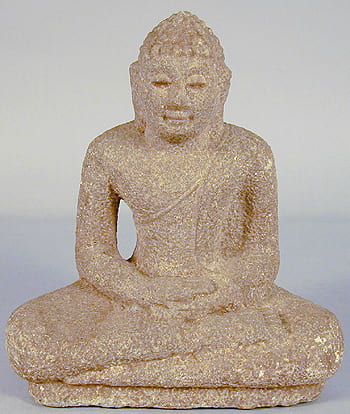
More about this artwork: This stone figure of the Buddha seated in a meditation pose is representative of Buddha images from Sri Lanka, where Buddhism, principally the Theravada tradition, has been practiced for more than two thousand years. Buddhist art in Sri Lanka has focused on the life of the Buddha and on events in his previous lives as a bodhisattva.
Many Sri Lankan figures are carved from stone or cast in bronze and then gilded. This Buddha is seated in the meditation pose with his hands together on his lap. He has an erect back and his eyes look straight ahead, a posture that is common in Sri Lankan images of the Buddha. The gentle features and simple treatment of the Buddha’s robe, which clings to his form, are also characteristic.
Two hundred years after the Buddha reached enlightenment under the Bodhi tree, a disciple brought a cutting from it and planted it in Sri Lanka, where a descendant of the tree flourishes today.
Seated Buddha
Sri Lanka, 12th century
Stone
Pacific Asia Museum Collection
Gift of Mark Phillips and Iuliana Phillips, 2001.56.62
5. Death of the Buddha
When the Buddha reached the age of 80 or 81, he knew his existence in human form was over. He traveled to a grove of trees in Kushinagara in northern India. There he died, surrounded by his followers, and attained parinirvana, or final release from the cycle of rebirth.
Despite the Buddha’s teaching that death is inevitable, his human followers and even the animals grieved. Only the cat, always detached, knew better than to mourn.
But that’s not the end of the story.
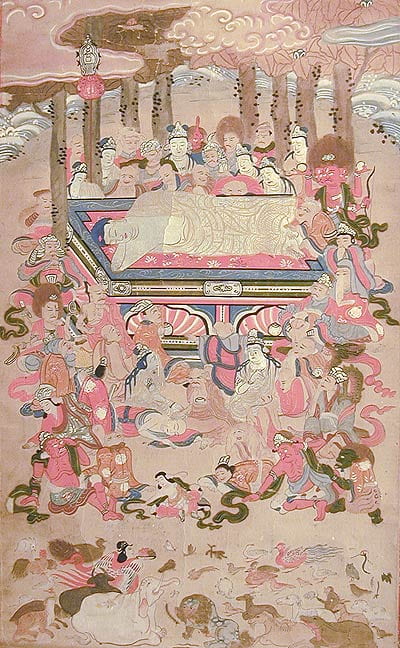
More about this artwork: This Japanese painting depicts the Buddha on his deathbed in a grove of trees, surrounded by mourning disciples and Buddhist deities. In the upper right corner, his mother Queen Maya, is shown descending from Heaven on a cloud to see her son in his physical form for the last time. At the foot of the painting are birds and animals who have also come to mourn his passing.
The Koreans introduced Buddhism to Japan in the 6th century A.D. During the ninth and tenth centuries, various forms of Mahayana Buddhism spread throughout the Japanese islands, first among the upper classes and then among the general populace. Buddhism became so important that it was sponsored by the state and the local Shinto beliefs incorporated into its teachings. By the time this work was created, Buddhism had ceased to be a state-sponsored religion in Japan.
The Death of the Buddha
Japan, 18th-19th century
Ink and colors on paper
Pacific Asia Museum Collection
Gift of Mr. Bill Kendall, 1994.48.2
6. The Buddha’s Words Live On
With the Buddha’s death, his followers saw that it was possible to break the endless Wheel of samsara, of birth, death, and rebirth. It really could be possible to attain enlightenment, to reach Nirvana. Roll your mouse over the image to see an example of a Tibetan wheel of birth, death, and rebirth.
In the decades and centuries that followed the Historical Buddha’s life, his followers memorized his teachings and passed along his wisdom. In time, these teachings and commentary and interpretation were written down in texts called sutras. Unlike Judaism, Christianity, and Islam, Buddhism has no one holy book that is considerted to be the word of god. Buddhist texts, nonetheless, are cherished and treated with great respect.
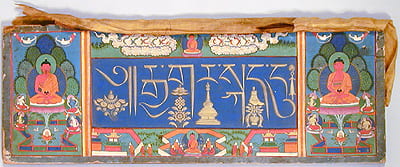
More about this artwork: In India, Nepal, and areas of Southeast Asia, many religious scriptures were hand written onto loose palm leaves and then tied together between two hard covers. The Tibetans increased the size of these manuscripts by replacing the palm leaves with paper. Manuscript covers were usually made of wood and were often decorated with gold or with paintings of the Buddhas, bodhisattvas, and deities. This example is similar to a sutra cover, but is actually the frontispiece for a Buddhist sutra. It features the images of the Buddha and important Buddhist symbols including the stupa, the Wheel of the Law, the vase of abundance, and the endless knot.
As seen here, letters and words in Sanskrit, the language of the sutras, are often incorporated into artworks.
Sutra Frontispiece
Tibet, 18th century
Wood, pigments, gesso, gilding and silk
Pacific Asia Museum Collection
Gift of David Kamansky in memory of Jerry Miles, 2002.20.2